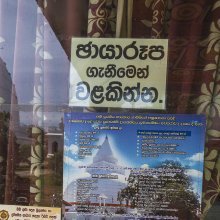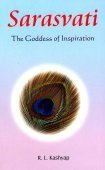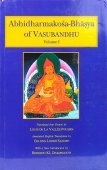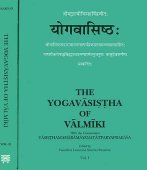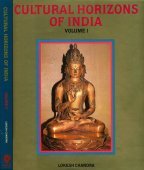Gatha, Gāthā, Gātha, Gaṭha: 29 definitions
Introduction:
Gatha means something in Buddhism, Pali, Hinduism, Sanskrit, Marathi, Hindi, biology. If you want to know the exact meaning, history, etymology or English translation of this term then check out the descriptions on this page. Add your comment or reference to a book if you want to contribute to this summary article.
Images (photo gallery)
In Hinduism
Purana and Itihasa (epic history)
Source: Google Books: Cultural History from the Vāyu PurānaThe term ‘gāthā’ (गाथा) occurs in the Ṛg-veda meaning usually a song or verse. The gāthās, though religious in content, are not mantras and hence are non-Vedic. In the aśvamedha sacrifice, as described in the Brāhmaṇas, we find mention of two lute-prayers, a Brahmin and a warrior, who in verses of their own composition (gāthās), glorified the generosity and war-like deeds of the sacrificer and his ancestors. With the fate of the aśvamedha, recitation of such gāthās also seems to have gone out of existence.
Source: archive.org: Shiva Purana - English TranslationGāthā (गाथा) refers to “ballads”, according to the Śivapurāṇa 2.3.44 (“Menā regains consciousness”).—Accordingly, as Menā said to her daughter (Pārvatī): “[...] Throwing away cooked rice you have eaten the husk. Spilling away the clarified butter you have eagerly swallowed castor oil. Setting the lion aside a jackal has been served by you. Without listening to the lore of Supreme Brahman you have heard base ballads (ku-gāthā). O daughter, casting off the holy sacrificial ashes at home you have taken the inauspicious ashes from the funeral pyre. [...]”.
Source: Cologne Digital Sanskrit Dictionaries: The Purana IndexGātha (गाथ).—Ancient popular songs; a feature of the Purāṇas; Nāraḍa on Vāli's sacrifices; on Pitṛs, on Yayāti, on Kārtavīrya, on Rāma;1 about Gayā and the Narmadā;2 sung by divine ṛṣis in Khaṭvānga's Yajña;3 by Prahlāda on Hari.4
- 1) Brahmāṇḍa-purāṇa II. 34. 21: III. 7. 272: 19. 9: 63. 192: 68. 96: 69. 19. IV. 15. 32: Matsya-purāṇa 43. 23: 204. 2 and 19: Viṣṇu-purāṇa III. 6. 15.
- 2) Matsya-purāṇa 22. 5: 186. 5: 207. 39-40.
- 3) Vāyu-purāṇa 60. 21: 73. 41: 83. 10: 88. 191: 93. 94: 94. 19: 96. 13.
- 4) Viṣṇu-purāṇa I. 17. 29.

The Purana (पुराण, purāṇas) refers to Sanskrit literature preserving ancient India’s vast cultural history, including historical legends, religious ceremonies, various arts and sciences. The eighteen mahapuranas total over 400,000 shlokas (metrical couplets) and date to at least several centuries BCE.
Chandas (prosody, study of Sanskrit metres)
Source: Shodhganga: a concise history of Sanskrit Chanda literature1) Gāthā (गाथा).—Piṅgala gives the definition of gāthā metres in the 8th chapter in 19 sūtras, where he discusses 18 gāthā metres. He says the metres which are not discussed in previous chapters is called as gāthā metres.
2) Gāthā (गाथा).—Śrī Kṛṣṇabhaṭṭa Kavikalānidhi (C. 1669-1744 C.E.), in his Vṛttamuktāvalī, divides the Gāthā type metres into seven viz. gāthikā, gāthā, vigāthā, udgāthā, gāthinī, siṃhinī, skandhā. He discusses the Gāthāprakaraṇa and other mātrā metres in the second chapters. Totally 44 metres in 67 verses are described in the second chapter.
3) Gāthā (गाथा) refers to one of the twenty-seven mātrāvṛttas (quantitative verse) dealt with in the second chapter of the Vṛttamuktāvalī, ascribed to Durgādatta (19th century), author of eight Sanskrit work and patronised by Hindupati: an ancient king of the Bundela tribe (presently Bundelkhand of Uttar Pradesh). A Mātrāvṛtta (e.g., gāthā) refers to a type of metre found in classical Sanskrit poetry.
Source: Journal of the University of Bombay Volume V: Apabhramsa metres (2)1) Gāthā (गाथा) is probably the oldest of the Prakrit meters and also the first mātrā-vṛtta which came to be very generally employed by the Sanskrit Pandits for the purposes of their scientific compositions and became their favourite owing to the great freedom and facility which it affords to the writer, in comparison with the epic Anuṣṭubh. It seems very probable that it was developed out of the epic Anuṣṭubh. It is interesting to note in this connection that according to a tradition of the older metricians followed also by Hemacandra, any metre which does not follow the laws governing the regular metres and hence cannot be included in any one of them, is to be called ‘Gāthā’.
The term gāthā is again used in Vedic Literature for any irregular metre; cf. the ‘Gāthās’ in the Hariścandra episode in the Aitareya-brāhmaṇa. [...] It appears however, that the Gāthā assumed its final form in the hands of the Sanskrit poet-philosophers, who as said above, abundantly used it for their scientific compositions. [...] That the Gāthā was a song metre is evident from the song of the Naṭī in the introduction to the Śākuntalam.
There are three main kinds of a Gāthā, i.e., Pathyā, Vipulā and Capalā. On the other hand, we get 26 varieties of a Gāthā if we base our division upon the number of short letters which they contain. The smallest number of short letters which a Gāthā may contain is 3 and such a Gāthā is called Kamalā; the largest number of short letters which it might contain is 55 and then it is called Gaurī. Among the metres derived from the Gāthā, Gīti, Upagīti and Udgīti are most important. Gīti is made with two first halves of a Gāthā, Upagīti with two second halves of it and Udgīti is nothing but an inverted or a reversed Gāthā.
2) Gātha (गाथ) is another name for Upagīti, which is a variation of Gāthā:—[...] Nanditāḍhya (Gāthālakṣaṇa, vv. 63-65) mentions Gīti, Upagīti and Udgīti respectively Udgātha, Gātha and Vigātha. Nanditāḍhya’s names are perhaps the older ones and are also adopted by Piṅgala at I.48, 49, 60-63.
3) Gātha (गाथ) is mentioned as another derivation of Gāthā.—Among the metres derived from the Gāthā, Gīti, Upagīti and Udgīti are most important. [...] By adding 1, 2, 4, 6, 8, 10, 12, and 14 caturmātras before the last long letter in the first half of a Gāthā, we respectively get a Jātiphala, Gātha, Udgātha, Vigātha, Avagātha, Saṃgātha, Upagātha and Gāthinī.
4) Gātha (गाथ) is also the name of a catuṣpadi metre (as popularly employed by the Apabhraṃśa bards), as discussed in books such as the Chandonuśāsana, Kavidarpaṇa, Vṛttajātisamuccaya and Svayambhūchandas.—Gātha (SIS, IIS, SS) is really varṇa-vṛtta, though it is defined as the mātrā-vṛtta with 13 mātrās in its lines.

Chandas (छन्दस्) refers to Sanskrit prosody and represents one of the six Vedangas (auxiliary disciplines belonging to the study of the Vedas). The science of prosody (chandas-shastra) focusses on the study of the poetic meters such as the commonly known twenty-six metres mentioned by Pingalas.
Natyashastra (theatrics and dramaturgy)
Source: Wisdom Library: Nāṭya-śāstraGāthā (गाथा) refers to one of the ten kinds of dhruvā (“songs”) defined in the Nāṭyaśāstra chapter 32. Accordingly, “the dhruvā is so called, because in it words, varṇas, alaṃkāra, tempo (laya), jāti and pāṇis are regularly (dhruva) connected with one another”.

Natyashastra (नाट्यशास्त्र, nāṭyaśāstra) refers to both the ancient Indian tradition (shastra) of performing arts, (natya—theatrics, drama, dance, music), as well as the name of a Sanskrit work dealing with these subjects. It also teaches the rules for composing Dramatic plays (nataka), construction and performance of Theater, and Poetic works (kavya).
Shaktism (Shakta philosophy)
Source: Brill: Śaivism and the Tantric Traditions (shaktism)Gāthā (गाथा) refers to “ballads (of renown)”, according to the King Vatsarāja’s Pūjāstuti called the Kāmasiddhistuti (also Vāmakeśvarīstuti), guiding one through the worship of the Goddess Nityā.—Accordingly, “[...] O goddess! You enter the heart of a man whose mind is composed. Sweet ballads (kīrti-gāthā) of your renown, O Gaurī, the Vidyādharas sing in the groves of Haricandana trees that emit the sweet fragrance of liquor on the banks of the heavenly river”.

Shakta (शाक्त, śākta) or Shaktism (śāktism) represents a tradition of Hinduism where the Goddess (Devi) is revered and worshipped. Shakta literature includes a range of scriptures, including various Agamas and Tantras, although its roots may be traced back to the Vedas.
Dharmashastra (religious law)
Source: Oxford Academic: Homo Ritualis: Hindu Ritual and Its Significance to Ritual TheoryGāthā (गाथा) refers to a “song”, according to Dadhirāma Marāsini’s 19th century Vivāhapaddhati (part of his Karmakāṇḍabhāskara) which is based on the Pāraskara-Gṛhyasūtra, a domestic manual in the Mādhyandina school of the Vājasaneyisaṃhitā.—If performed traditionally, high caste marriages among the Parbatiyas (Parbates/Paharis/Pahadis) or Indo-Nepalese people in Nepal are normally executed by following the course of events as presented in marriage manuals. The Gāthā-āgāna rite is mentioned under the header called Other vivāha rites.

Dharmashastra (धर्मशास्त्र, dharmaśāstra) contains the instructions (shastra) regarding religious conduct of livelihood (dharma), ceremonies, jurisprudence (study of law) and more. It is categorized as smriti, an important and authoritative selection of books dealing with the Hindu lifestyle.
In Buddhism
Theravada (major branch of Buddhism)
Source: Pali Kanon: Pali Proper NamesA portion of the Tipitaka classified according to the matter (anga) of each one.
It includes the Dhammapada, the Theragatha and Therigatha, and those suttas, composed of stanzas only, found in the Sutta Nipata and not included under the term Sutta. DA.i.23f; Vin.iii.8.
Source: Dhamma Dana: Pali English GlossaryF Knowledge and ethics imparted by means of speech or scriptures. Formula expressing some knowledge under the shapes of verses.
Theravāda is a major branch of Buddhism having the the Pali canon (tipitaka) as their canonical literature, which includes the vinaya-pitaka (monastic rules), the sutta-pitaka (Buddhist sermons) and the abhidhamma-pitaka (philosophy and psychology).
Mahayana (major branch of Buddhism)
Source: Wisdom Library: Maha Prajnaparamita SastraGathā (गथा, “stanza”) refers to one of the twelve members of Buddhist texts (dvādaśāṅga), according to a note attached to the Mahāprajñāpāramitāśāstra chapter 51.—All the kie ‘verses’, if they are composed of six, three or five metric feet (pada) or an undetermined number of metric feet, are called k’i-ye ‘geya’ and also k’ie-to, ‘gathā, stanza’
Source: academia.edu: A Study and Translation of the Gaganagañjaparipṛcchā
Gātha (गाथ) (Cf. Śloka) refers to “verses”, according to the Gaganagañjaparipṛcchā: the eighth chapter of the Mahāsaṃnipāta (a collection of Mahāyāna Buddhist Sūtras).—Accordingly, “[...] Then a voice resounded from open space, saying: ‘The Bodhisattva, the great being Gaganagañja has praised in verses (gātha-abhigīta) the complete unsurpassable awakening which has been fully accomplished by the Buddhas in uncountable hundreds, thousands, millions, billions of ages. However, these Bodhisattvas cannot see this [awakening] as object even in their dreams because of their attachment. Having heard this guiding principle of the dharma in verses, attained it and believe it, whoever will gradually attain the lion’s roar like that of Bodhisattva Gaganagañja’.”

Mahayana (महायान, mahāyāna) is a major branch of Buddhism focusing on the path of a Bodhisattva (spiritual aspirants/ enlightened beings). Extant literature is vast and primarely composed in the Sanskrit language. There are many sūtras of which some of the earliest are the various Prajñāpāramitā sūtras.
General definition (in Buddhism)
Source: Buddhist Door: GlossaryAncient Indian verse.Biology (plants and animals)
Source: Wisdom Library: Local Names of Plants and DrugsGatha in the Angami language is the name of a plant identified with Houttuynia cordata Thunb. from the Saururaceae (Lizard-tail) family having the following synonyms: Houttuynia foetida, Polypara cordata. For the possible medicinal usage of gatha, you can check this page for potential sources and references, although be aware that any some or none of the side-effects may not be mentioned here, wether they be harmful or beneficial to health.
Gatha in the Telugu language is the name of a plant identified with Diospyros sylvatica Roxb. from the Ebenaceae (Ebony) family.

This sections includes definitions from the five kingdoms of living things: Animals, Plants, Fungi, Protists and Monera. It will include both the official binomial nomenclature (scientific names usually in Latin) as well as regional spellings and variants.
Languages of India and abroad
Pali-English dictionary
Source: BuddhaSasana: Concise Pali-English Dictionarygāthā : (f.) deep. (m.), depth; a safe stand; foothold.
Source: Sutta: The Pali Text Society's Pali-English DictionaryGāthā, (f.) (Vedic gāthā, on dern see gāyate) a verse, stanza, line of poetry, usually referring to an Anuṭṭhubbaṃ or a Tuṭṭhubbaṃ, & called a catuppādā gāthā, a stanza (śloka) of four half-lines A.II, 178; J.IV, 395. Def. as akkhara-padaniya-mita-ganthita-vacanaṃ at KhA 117. For a riddle on the word see S.I, 38. As a style of composition it is one of the nine Aṅgas or divisions of the Canon (see navaṅga Satthu sāsana). Pl. gāthā Sn.429; J.II, 160; gāthāyo Vin.I, 5, 349; D.II, 157. gāthāya ajjhābhāsati to address with a verse Vin.I, 36, 38; Kh v. intr.—gāthāhi anumodati to thank with (these) lines Vin.I, 222, 230, 246, 294, etc.—gāthāyo gīyamāna uttering the lines Vin.I, 38.—anantaragāthā the foll. stanza J.IV, 142; Sn.251; J.I, 280; Dh.102 (°sataṃ).

Pali is the language of the Tipiṭaka, which is the sacred canon of Theravāda Buddhism and contains much of the Buddha’s speech. Closeley related to Sanskrit, both languages are used interchangeably between religions.
Marathi-English dictionary
Source: DDSA: The Molesworth Marathi and English Dictionarygāṭhā (गाठा).—m (gāṇṭha) A large silver ring worn by the worshipers of Khanḍoba around the neck.
--- OR ---
gāthā (गाथा).—f (S) Unmetrical composition; simple prose. 2 A period or sentence. 3 Idle chat; floating news. v sāṅga, kuṭa.
--- OR ---
gāthā (गाथा).—m Jumbledness, confusedly mingled state. 2 Rumpled state.
Source: DDSA: The Aryabhusan school dictionary, Marathi-Englishgāthā (गाथा).—f Unmetrical composition, simple prose. A period or sentence. Idle chat, floating news. v sāṅga, kūṭa. m Thumbled- ness, confusedly mingled state.
Marathi is an Indo-European language having over 70 million native speakers people in (predominantly) Maharashtra India. Marathi, like many other Indo-Aryan languages, evolved from early forms of Prakrit, which itself is a subset of Sanskrit, one of the most ancient languages of the world.
Sanskrit dictionary
Source: DDSA: The practical Sanskrit-English dictionaryGātha (गाथ).—See under गै (gai) .
See also (synonyms): gāthaka.
--- OR ---
Gātha (गाथ).—A song, singing.
Derivable forms: gāthaḥ (गाथः).
--- OR ---
Gāthā (गाथा).—
1) Verse.
2) A religious verse, but not belonging to any one of the Vedas.
3) A stanza.
4) A song; कदा वाहेयिका गाथाः पुनर्गास्यामि शाकले (kadā vāheyikā gāthāḥ punargāsyāmi śākale) Mahābhārata (Bombay) 8.44.26.
5) A Prākṛta dialect.
6) Name of the Aryā metre.
7) Legend, history (ākhyāna); द्विजोपसृष्टः कुहकस्तक्षको वा दशत्वलं गायत विष्णुगाथाः (dvijopasṛṣṭaḥ kuhakastakṣako vā daśatvalaṃ gāyata viṣṇugāthāḥ) Bhāgavata 1.19.15.
Source: Cologne Digital Sanskrit Dictionaries: Shabda-Sagara Sanskrit-English DictionaryGāthā (गाथा).—f.
(-thāṃ) 1. A verse, a stanza. 2. Metre, rhythm. 3. A song, a chant or verse to be chanted or sung. 4. Prakrita or any language not Sanskrit. 5. The same as the Aryya Metre, in which the verse contains sixty syllabic instants, variously arranged. E. gai to sing, than Unadi aff.
Source: Cologne Digital Sanskrit Dictionaries: Benfey Sanskrit-English DictionaryGāthā (गाथा).—i. e. gai + tha, f. A song, a verse, [Indralokāgamana] 2, 28; [Mānavadharmaśāstra] 9, 42.
Source: Cologne Digital Sanskrit Dictionaries: Cappeller Sanskrit-English DictionaryGātha (गाथ).—[masculine] song; [feminine] gāthā the same, [especially] a kind of rel. verse or stanza; [Name] of a metre ( = āryā).
Source: Cologne Digital Sanskrit Dictionaries: Monier-Williams Sanskrit-English Dictionary1) Gātha (गाथ):—[from gā] a m. a song, [Ṛg-veda i, 167, 6 and ix, 11, 4; Sāma-veda]
2) Gāthā (गाथा):—[from gātha > gā] a f. idem, [Ṛg-veda]
3) [v.s. ...] a verse, stanza (especially one which is neither Ṛc, nor Sāman, nor Yajus, a verse not belonging to the Vedas, but to the epic poetry of legends or Ākhyānas, such as the Śunaḥśepa-Ākhyāna or the [Suparṇādhyāya]), [Atharva-veda; Taittirīya-saṃhitā; Taittirīya-brāhmaṇa; Śatapatha-brāhmaṇa] etc.
4) [v.s. ...] the metrical part of a Sūtra, [Buddhist literature]
5) [v.s. ...] Name of the Āryā metre
6) [v.s. ...] any metre not enumerated in the regular treatises on prosody (cf. ṛg-gāthā, riju-gātha, yajña-gāthā.)
7) [from gā] b f. of tha q.v.
8) Gātha (गाथ):—[from gātu] b See 3. gā.
9) Gāthā (गाथा):—[from gātu] c See 3. gā.
Source: Cologne Digital Sanskrit Dictionaries: Yates Sanskrit-English DictionaryGāthā (गाथा):—(thā) 1. f. A verse, metre, song.
Source: DDSA: Paia-sadda-mahannavo; a comprehensive Prakrit Hindi dictionary (S)Gāthā (गाथा) in the Sanskrit language is related to the Prakrit word: Gāhā.
[Sanskrit to German]
Sanskrit, also spelled संस्कृतम् (saṃskṛtam), is an ancient language of India commonly seen as the grandmother of the Indo-European language family (even English!). Closely allied with Prakrit and Pali, Sanskrit is more exhaustive in both grammar and terms and has the most extensive collection of literature in the world, greatly surpassing its sister-languages Greek and Latin.
Hindi dictionary
Source: DDSA: A practical Hindi-English dictionaryGāthā (गाथा):—(nf) a tale; narrative; ballad; ~[kāra] author of a narrative tale.
...
Kannada-English dictionary
Source: Alar: Kannada-English corpusGātha (ಗಾಥ):—
1) [noun] a piece of music sung or composed for singing; a song.
2) [noun] a poetical composition; a poem or verse.
Kannada is a Dravidian language (as opposed to the Indo-European language family) mainly spoken in the southwestern region of India.
See also (Relevant definitions)
Starts with (+21): Gathabamdhana, Gathabandhana, Gathabhigita, Gathadem, Gathadi, Gathadvaya, Gathagadi, Gathagana, Gathagova, Gathaja, Gathajananaka, Gathajoda, Gathaka, Gathakara, Gathakosha, Gathakoshabahvi, Gathala, Gathalem, Gathali, Gathan.
Ends with (+46): Abhisambuddha Gatha, Abhiyajnagatha, Akatigatha, Angatha, Avagatha, Bilugatha, Cadengatha, Dasavaragatha, Gauravagatha, Govalagatha, Indragatha, Jayagatha, Kayaviratigatha, Kirtigatha, Koradya Gatha, Kugatha, Lokagatha, Malagatha, Mukata, Munigatha.
Full-text (+252): Gathika, Avagatha, Pararkshatagatha, Gathakara, Vigatha, Samgatha, Gathapati, Udgatha, Gathani, Gathantara, Gathin, Riggatha, Yajnagatha, Sthaviragatha, Udgiti, Giti, Upagiti, Tut gatha, Yamagatha, Upagatha.
Relevant text
Search found 105 books and stories containing Gatha, Gāthā, Gātha, Gaṭha, Gāṭhā; (plurals include: Gathas, Gāthās, Gāthas, Gaṭhas, Gāṭhās). You can also click to the full overview containing English textual excerpts. Below are direct links for the most relevant articles:
Rig Veda (translation and commentary) (by H. H. Wilson)
Sahitya-kaumudi by Baladeva Vidyabhushana (by Gaurapada Dāsa)
Text 4.55 < [Chapter 4 - First-rate Poetry]
Text 10.8 < [Chapter 10 - Ornaments of Meaning]
Text 10.183 < [Chapter 10 - Ornaments of Meaning]
Guide to Tipitaka (by U Ko Lay)
Part 13 - Apadana Pali < [Chapter VIII - Khuddaka Nikaya]
Part 9 - The Theri Gatha Pali < [Chapter VIII - Khuddaka Nikaya]
Part 8 - The Thera Gatha Pali < [Chapter VIII - Khuddaka Nikaya]
Sutrakritanga (English translation) (by Hermann Jacobi)
A Manual of Khshnoom (by Phiroz Nasarvanji Tavaria)
The Catu-Bhanavara-Pali (critical study) (by Moumita Dutta Banik)
(12) Mettanisamsa-gatha Sutta < [Chapter 2 - Subject Matter of the First Bhanavara]
Efficiency of Paritta (Buddhist protecting charms) < [Chapter 1 - Introduction]
All-Night chanting < [Chapter 1 - Introduction]
Related products
